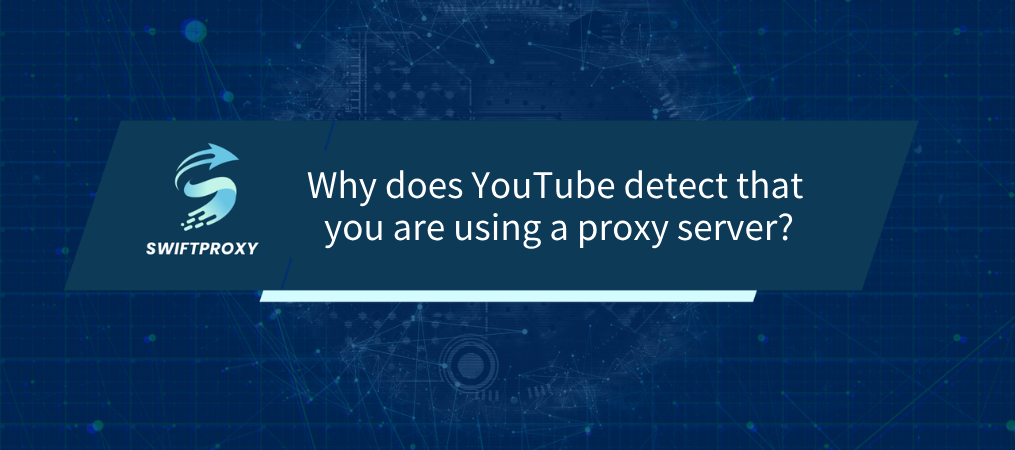Why does YouTube detect that you are using a proxy server?

As the world's largest video sharing platform, YouTube has attracted hundreds of millions of users. However, for various reasons, some users may choose to use a proxy server to access YouTube. So, why does YouTube detect that users are using a proxy server? This article will explore this.
Why do you need to use a proxy server to access YouTube?
There are several reasons why you need to use a proxy server to access YouTube:
1. Geographical restrictions
YouTube may be restricted or blocked in some areas and cannot be accessed directly using the local network. Proxy servers can bypass these geographical restrictions and allow users to watch YouTube videos.
2. Network security and privacy protection
Using a proxy server can add a layer of network security protection to prevent personal information from being leaked or maliciously attacked. When browsing the web through a proxy server, the server will first send a request to the target website, return the required data and display it on the user's device, which can hide the user's true identity and online behavior.
3. Speed up network access
In some cases, YouTube's servers may become slow or directly unable to connect for various reasons. Using a proxy server may improve this situation because it may provide a more stable connection or faster response speed.
How does YouTube detect the use of a proxy server?
1. IP address analysis
First, YouTube may detect whether a user is using a proxy server through IP address analysis. Each device is assigned a unique IP address when it connects to the Internet, which is like a "digital ID card" for the device. When a user accesses YouTube through a proxy server, although the user's real IP address is hidden, the IP address of the proxy server is exposed to YouTube. If YouTube finds that an IP address comes from different geographical locations or serves a large number of users in a short period of time, it may mark this IP address as the IP of a proxy server, thereby inferring that the user is using a proxy.
2. Network traffic pattern analysis
Second, YouTube may also detect the use of a proxy server by analyzing network traffic patterns. When a proxy server forwards network requests, it generates specific traffic patterns. These patterns may be different from the direct access patterns of ordinary users. For example, a proxy server may process requests from multiple users at the same time, resulting in abnormal traffic peaks and fluctuation patterns. YouTube's algorithm can identify these abnormal patterns and determine whether the user is using a proxy based on this.
3. Login and behavior pattern analysis
In addition, YouTube also analyzes the user's login and behavior patterns to detect the use of a proxy server. If a user frequently changes login locations or exhibits abnormal behavior patterns when using a proxy server (such as watching a large number of videos in a short period of time, frequently liking or commenting, etc.), these behaviors may not be consistent with the normal usage patterns of ordinary users. YouTube's monitoring system may capture these abnormal behaviors and conduct further analysis and judgment on them.
What are the consequences of YouTube detecting the use of a proxy server?
- Restricted access: YouTube may restrict or block access through proxy servers, resulting in the inability to watch videos or perform other operations normally.
- Account blocking: If you frequently or heavily use proxy servers to access, YouTube may regard it as a violation and block your account.
- Content restrictions: Some content may be restricted from viewing due to region or proxy servers, affecting user experience.
- Security verification: Users may be required to perform additional security verification, such as mobile phone verification, email verification, etc., to confirm their identity.
How to simulate real access to YouTube?
- Choose Swiftproxy high-quality residential proxy: Use Swiftproxy's high-anonymity, stable, and fast proxy server to ensure that the access process will not be easily detected.
- Use fingerprint browser: Using fingerprint browser can effectively hide the real identity and device information, reducing the risk of being detected by YouTube to use proxy or associated accounts.
- Reasonable browser settings: Clear the browser cache and simulate the browsing behavior of real users, such as normal browsing, clicking, staying, etc., to avoid triggering the website's protection strategy.
- Control access frequency: Do not visit YouTube frequently and in large quantities, simulate the access frequency of ordinary users, and reduce the risk of being identified.
- Use a normal account: If possible, use a normal YouTube account to log in and access to increase the authenticity of the access.
Conclusion
To sum up, YouTube may detect whether users are using proxy servers through methods such as IP address analysis, network traffic pattern analysis, and login and behavior pattern analysis. As users, we should understand these detection methods and use proxy servers legally and ethically. While enjoying the convenience brought by the Internet, we must also abide by relevant laws and regulations and platform regulations to jointly maintain a healthy and safe network environment.

















































